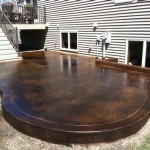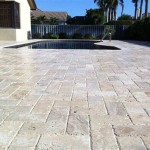How To Paint a Concrete Patio Around a Pool
Painting a concrete patio surrounding a pool can drastically improve the aesthetic appeal of the outdoor space, providing a fresh, clean look and enhancing the overall poolside experience. However, proper preparation and application are crucial for achieving a durable and visually pleasing finish that can withstand the harsh conditions often associated with pool areas, including constant moisture, exposure to sunlight, and the presence of pool chemicals. This article will outline the necessary steps to successfully paint a concrete patio around a pool, emphasizing the importance of surface preparation, selecting the appropriate paint and supplies, and applying the paint correctly.
Assessing the Concrete Patio and Preparing the Surface
The success of any paint job hinges on the quality of the surface preparation. A poorly prepared surface will invariably lead to paint failure, resulting in peeling, cracking, and ultimately, a wasted effort. Begin with a thorough assessment of the concrete patio's condition. Look for cracks, stains, mildew, or any existing coatings that need addressing before proceeding.
The first step in cleaning the patio is to remove loose debris. Sweep the entire area to eliminate dirt, leaves, and any other loose particles. A stiff-bristled broom is ideal for this task.
Next, thoroughly clean the concrete using a pressure washer. This is perhaps the most crucial step in preparing the surface, as it removes embedded dirt, grime, and mildew that could prevent the paint from adhering properly. Use a pressure washer with a wide-angle nozzle to avoid damaging the concrete surface. Apply a concrete cleaner solution specifically designed for outdoor use prior to pressure washing. Follow the manufacturer's instructions for dilution and application. Allow the cleaner to sit on the surface for the recommended time before rinsing thoroughly with the pressure washer.
Address any stains or problem areas. Oil stains can be particularly stubborn and may require a degreaser specifically formulated for concrete. Apply the degreaser according to the manufacturer's instructions and scrub the affected area with a stiff brush. Rinse thoroughly with water.
Inspect the patio for cracks. Small hairline cracks can often be filled with a concrete patching compound. Deeper or wider cracks may require a more robust repair using a concrete crack filler. Follow the manufacturer's instructions for application and curing time. Allow the patching compound or crack filler to dry completely before proceeding. Once dry, sand down the repaired areas to create a smooth, even surface that blends seamlessly with the surrounding concrete.
If an existing coating is present, it must be properly prepared. If the coating is peeling or flaking, it needs to be completely removed. This can be done using a paint scraper, wire brush, or, in more severe cases, a chemical stripper. Ensure the stripper is compatible with concrete and follow the manufacturer’s safety precautions. After stripping, thoroughly clean the surface to remove any residue. If the existing coating is in good condition, lightly sand it to create a rough surface that will promote adhesion of the new paint.
Once the cleaning and repairs are complete, allow the concrete to dry completely. This can take several days depending on the weather conditions. Moisture trapped within the concrete can lead to paint failure, so it is imperative to ensure the surface is thoroughly dry before proceeding.
Selecting the Appropriate Paint and Applying Primer
Choosing the right paint is just as important as preparing the surface. Not all paints are suitable for concrete patios, especially those around pools. The paint must be durable, water-resistant, and able to withstand the constant exposure to sunlight and pool chemicals.
Acrylic concrete paint is a popular choice for pool patios. It is durable, easy to apply, and resistant to fading and cracking. It also provides good water resistance, which is essential for areas around pools. Epoxy paint is another option, offering superior durability and chemical resistance compared to acrylic. However, it can be more difficult to apply and may require professional installation. Chlorinated rubber paint, while traditionally used for pools, can also be applied to the surrounding patio for aesthetic consistency, however, it is less environmentally friendly and its use is declining. Look for paints specifically formulated for concrete surfaces and labeled as suitable for exterior use. Check the manufacturer's specifications for compatibility with pool chemicals.
The application of a primer is highly recommended. A concrete primer will improve the adhesion of the paint, ensuring a longer-lasting and more durable finish. Primer also helps to seal the concrete surface, preventing moisture from penetrating the paint and causing blistering or peeling. Choose a primer specifically designed for concrete and compatible with the chosen paint. Apply the primer according to the manufacturer's instructions using a roller or brush. Allow the primer to dry completely before proceeding with the paint application. Typically, this takes between 24 and 48 hours, depending on the weather conditions.
Consider adding a non-slip additive to the paint or primer, especially around a pool area where surfaces can become slippery when wet. This additive will improve traction and reduce the risk of slips and falls. Mix the non-slip additive thoroughly into the paint or primer according to the manufacturer’s instructions. Do not over-apply the additive, as this can affect the paint’s appearance and performance. Test a small area first to ensure the desired texture and finish are achieved.
Painting the Concrete Patio and Ensuring Proper Curing
With the surface properly prepared and the appropriate paint and primer selected, the next step is to apply the paint. Choose a day with favorable weather conditions. Avoid painting in direct sunlight or when rain is expected. The ideal temperature range for painting concrete is typically between 50°F and 90°F (10°C and 32°C). High humidity can also affect the drying time and the overall quality of the finish.
Begin by applying the paint around the edges of the patio using a brush. This is known as "cutting in" and ensures a clean, even line along walls, railings, and other obstacles. Use a high-quality paintbrush with synthetic bristles for best results. Apply the paint in smooth, even strokes, avoiding drips and runs.
Once the edges are complete, use a roller to apply the paint to the remaining surface. Use a roller with a nap that is appropriate for the texture of the concrete. A rougher surface will require a roller with a thicker nap to ensure adequate coverage. Apply the paint in a consistent direction, overlapping each stroke slightly to avoid gaps or streaks. Maintain a wet edge to ensure a seamless finish.
Apply at least two coats of paint for optimal durability and coverage. Allow the first coat to dry completely before applying the second coat. Follow the manufacturer's instructions for drying time, which can vary depending on the type of paint and the environmental conditions. Applying the second coat before the first coat is completely dry can result in bubbling, peeling, or a soft, uneven finish.
After applying the final coat of paint, allow the patio to cure completely before allowing foot traffic or placing furniture on it. Curing involves allowing the paint to harden fully, which can take several days. Follow the manufacturer's instructions for curing time. Protect the painted surface from rain and direct sunlight during the curing process. Covering the patio with plastic sheeting can help to protect it from the elements.
After the curing process is complete, inspect the painted surface for any imperfections. Touch up any areas that may require additional attention. Consider applying a concrete sealer to further protect the paint from moisture, sunlight, and pool chemicals. A sealer will also enhance the durability of the finish and make it easier to clean. Apply the sealer according to the manufacturer’s instructions.
Regular maintenance will help to prolong the life of the painted concrete patio. Sweep the surface regularly to remove dirt and debris. Clean spills promptly to prevent staining. Avoid using harsh chemicals or abrasive cleaners, as these can damage the paint. Periodically inspect the painted surface for cracks, peeling, or other signs of damage and address any issues promptly. Reapply the sealer as needed to maintain the protective barrier.

Concrete Pool Deck Paint Painted Around Network

Painting A Concrete Pool Deck What To Consider Resurfacing

Painting A Concrete Pool Deck What To Consider Resurfacing

Concrete Pool Deck Paint Painted Around Network

Update Your Pool Deck

Ultimate Guide For Refinishing Pool Deck Encore Coatings

Concrete Pool Deck Paint Painted Around Network

Protect Seal Your Pool Deck

Selecting The Best Pool Concrete Deck Stain A How To Guide Painted Stained

Paint Concrete Pool Deck Henderson Wallcovering Painting
Related Posts








